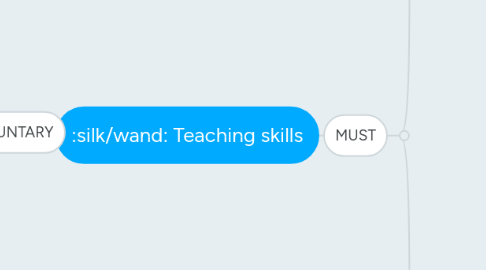
1. MUST
1.1. Listening
1.1.1. Teaching Listening ALINA
1.1.1.1. Children will listen to a great variety of texts but the main input is the teacher
1.1.1.1.1. talking, singing, chanting, dramatizing dialogues, giving instructions and telling stories
1.1.1.1.2. they also listen to video and audio tapes (if these come with the teacher's coursebook)
1.1.2. Listening - Aspects of difficulty ALINA
1.1.2.1. type and lenght of the text
1.1.2.2. familiarity of the person who they are listening to
1.1.2.2.1. it's easier to listen to the teacher than to recordings because the teacher can control the speed and also repeat massages and use gestures
1.1.2.3. basic sub-skills
1.1.2.3.1. bottum-up
1.1.2.3.2. top-down
1.1.3. Support with listening VIKTORIA
1.1.3.1. bottom-up
1.1.3.2. top-down
1.1.4. Teacher Talk ANNIKA
1.1.4.1. Interactional modifications = extra Punkt zu bearbeiten
1.1.4.2. Teacher should talk in the target language.
1.1.4.2.1. Pupils get used to intonation patterns and sounds of language.
1.1.4.2.2. Teacher accepts when the children answer and comment in their mother tongue.
1.1.4.3. Use repetition, comprehension (Do you understand what I want to say?) and confirmation checks (Did you say...?)
1.1.5. Activities
1.1.5.1. Activities for young learners ANNETTE
1.1.5.1.1. It's important that children have the opportunity to absorb the language before they have to say anything.
1.1.5.2. Activities for older learners ANNA KLEE
1.1.5.2.1. They may not understand every word, they get the meaning from the context, the gestures and the visual aids.
1.1.5.2.2. Most of the activities for young learnes can be adapted for older ones by getting it on a higher level
1.1.5.2.3. Older learners can use their reading and writing skills to their advantage in listening activities.
1.2. Speaking
1.2.1. speaking fluently SARAH
1.2.1.1. speaking & thinking at the same time
1.2.1.2. a lot of practice is necessary
1.2.1.2.1. set phrases and repeating models
1.2.1.2.2. spontaneous contributions
1.2.2. What is realistic MARLENE
1.2.3. Activities with younger groups LISA L.
1.2.3.1. Teaching chunks/phrases and not single words will make the kids more secure in speaking. They don't have to put together single words but reapeat whole phrases which they have heard earlier. So they practice speaking without having to think about grammar and vocab.
1.2.3.2. Fully fixed chunks (don't have to be changed by the kids at all) e.g.: See you tomorrow, What do you like? -> Children will understand and copy them without knowing every single word.
1.2.3.3. Partially fixed chunks ( phrases which have to be completed by the kids) e.g.: I like/don't like......Are you a....? My name is.....
1.2.3.3.1. guessing games: one child comes to the front and acts out an animal/ a profession.... The others have to guess by using this phrase: Are you a/an.....?
1.2.3.3.2. producing surveys in the class, e.g. by asking the question: Do you like....?
1.2.3.4. These chunks can be learnt by the teacher's input or from songs, rhymes, dialogues stories etc. The exercises should give everybody a chance to talk, should be meaningful and fun. (=
1.2.4. Activities with older groups ALINA
1.2.5. The demand of more complex tasks EILEEN
1.2.5.1. Information gap tasks, discussion tasks and other complex speaking tasks
1.2.5.1.1. with information gap tasks, where student A and B have different informations, children say things creatively on the spot. The children learn to pay attention to what their partner is saying
1.2.5.1.2. it is important to explore these difficulties with their children and provide plenty of practice of new task types
1.2.5.1.3. That has to be mentioned:
1.2.5.1.4. Parents can also help: listen to songs, rhymes, and chants, practise dialogues, and encourage any discussion about english
2. VOLUNTARY
2.1. Reading
2.1.1. Those pages are to be found in the library
2.2. Writing
2.2.1. Those pages are to be found in the library
